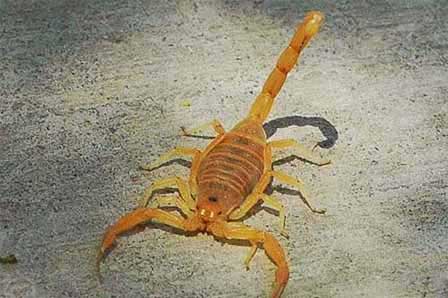Arizona Bark Scorpion
 Arizona Bark Scorpion. Creative Commons Wikipedia
Arizona Bark Scorpion. Creative Commons WikipediaBefore getting to the Bark Scorpion, let's talk about Scorpions in general. Scorpions have existed for at least 430 million years. Although tiny, they do look prehistoric. They are very frightening looking creatures and the mere sight can send some people into a serious state of anxiety.
All scorpions are venomous, but very few species are considered dangerous. By varying accounts, there are over 1400 species worldwide of which only 90 exist is the United States. About 40 are unique to Arizona and the Southwest as well as northern Mexico. One of those is the feared "Bark Scorpion", the only one in the US considered dangerous.
Arizona Bark Scorpion Facts
It is the most venomous scorpion in America. But let's put your mind at ease. Deaths from the sting of the bark scorpion are extremely rare. According to research biologists at Arizona State University, there has not been a recorded death by any scorpion sting in Arizona for over 40 years.
The Bark Scorpion is the smallest scorpion but packs the biggest punch. The adults range from 2 to 3 inches long, including its tail. It is almost of uniform color ranging from tan to tan-yellow. Whereas the Bark Scorpion primarily inhabits arid desert regions, it's cousin, the Striped Bark Scorpion is found at higher elevations and is identified by dark horizontal stripes.
These guys are adept at climbing walls and trees (hence the name "bark"). That's why they are often found inside homes. They climb seeking points of entry. With flat, thin bodies, they can squeeze through the tiniest places as small as 1/16". Particularly during the heat of summer, they are seeking cool, dark places that also harbor their favorite insect menu.
Arizona Bark Scorpions
- Belong to arachnid family (not insects) along with spiders and ticks.
- Have 8 legs and 8 eyes.
- Have poor vision. Only detect light and dark.
- Females give live birth during summer months.
- Young ride on mother's back for 7-10 days before dispersing.
- It is nocturnal. Hunts at night.
- Is solitary but not especially territorial.
- Hibernates during winter months.
- Lifespan is about 5 to 9 years
- After mating, the male is often eaten by the female.
- Most potent venom of scorpion species in North America.
- Venom is a neuro-toxin held in gland at tip of its tail.
- Venom is injected by a stinger at the end of its tail.
Range, Habitat and Behavior
Range. The range of the Bark Scorpion is primarily Arizona extending to the extreme southeastern portion of California and southwestern New Mexico, both along the borders of Arizona. Heavy populations also inhabit Mexico in Baja California Norte, Baja California Sur and Sonora.
Habitat. The Bark Scorpion primarily prefers to inhabit arid desert regions. The fat layers on its exoskeleton makes it resistant to water loss but still prefers to locate in riparian areas around moisture because those same conditions attract its main prey of insects.
It is nocturnal. Hunts by night and hides during the day under rocks, dead logs, wood piles, under bushes and behind vines against walls. It loves to hide within tree bark of mesquite trees and under palm tree fronds. Inside homes they will seek shelter in dark, cool and humid places.
It is not coincidental that their preferred environments are identical as those that attract insects. When idle, bark scorpions prefer an upside down position which is why many people are stung accidentally when reaching underneath an object such as a piece of firewood, a rock or a piece of wood. Warning. Inside homes, these creatures will crawl inside shoes where it is moist and dark.
Diet of the Bark Scorpion. They ambush insects and some spiders. Among its diet are roaches, crickets, beetles and all small insects. It will occupy areas that attract its prey. If you want to help protect your home from any type of scorpion, practice cleanliness. If your home is not enticing to insects, your home is less likely to attract scorpions.
Mating and Life Cycle. The scorpion reaches full-grown over a course of 5 years and its lifespan ranges from 5 to 10 years. As it grows, it will molt out of its hard exoskeleton several times. The process is done by turning on its back, cracking open and slipping out of the exoskeleton, then puffing up and hardening again. Having wasted so much energy and being soft right after molting, it is very vulnerable to predators during the process.
During mating the male and female have a unique courtship. While the male holds the female's pincers they spend several hours turning round and round. He deposits sperm on the ground and pulls her over it. She absorbs the sperm through a sexual opening under her abdomen.
The Bark Scorpion gives live birth after a gestation period of several months. Eggs develop inside the females body and break after gestation releasing fully developed offspring. The newly born will ride on the mother's back for a week or so until reaching their first molt at which time they disperse and become independent. Offspring can number up to 30.
Venom of The Bark Scorpion
For clarification, scorpions (like venomous snakes and spiders) are referred to as "venomous" and not "poisonous". Venom is injected by an animal whereas poison (poison plant life and toxic chemicals) are absorbed or ingested.
All scorpions have venom. The impact of a scorpion sting varies by species. The potency of most types of scorpion stings are no more serious than a bee sting. However, the venom of a Bark Scorpion packs a punch that is much more severe with very intense pain accompanied by hot burning sensation.
In some cases its sting can become substantially more serious with breathing difficulty , numbness, frothing at the mouth, vomiting, and even convulsions. Difficulty swallowing is typically a sign of an allergic reaction. When the above symptoms are present, victims must seek emergency medical care where anti-venom is available.
The most vulnerable are infants, young children, the elderly and those with compromised immunity in poor health. Domestic pets are also vulnerable.
Scorpion Anatomy

More Information and Suggested Reading
Avoiding and Protection Against Scorpion Stings
What To Do If You Are Stung By A Scorpion
Other Arizona Venomous Animals
Arizona Poison Control Center
(602) 635-3226 (Banner Health)
1-800-222-1222 American Poison Control Center)
Arizona Animals















